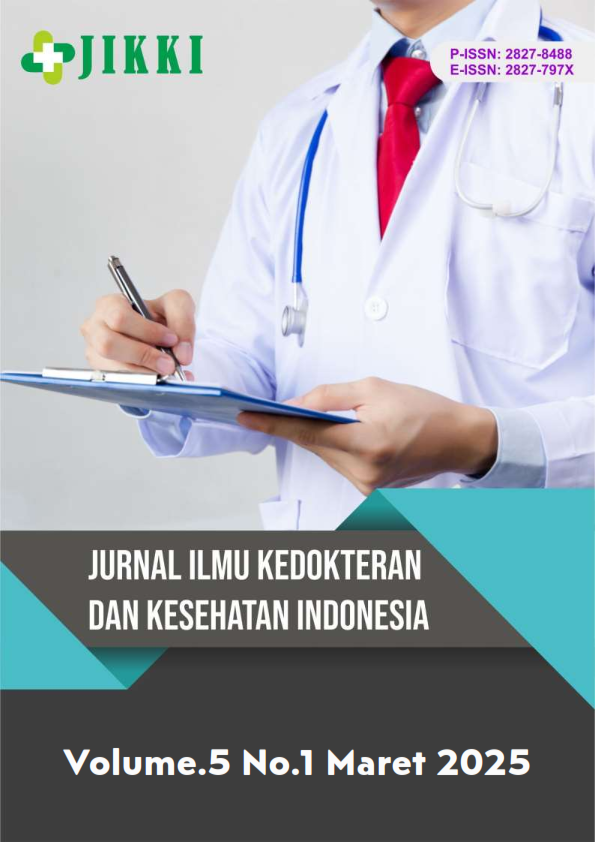Analysis of the Management of the Integrated Non-Communicable Disease Control Program (Posbindu-PTM) in the Working Area of Rawasari Public Health Center in 2024
DOI:
https://doi.org/10.55606/jikki.v5i1.5666Keywords:
Management, Posbindu NCDs, Cadres, Non-Communicable DiseasesAbstract
Non-Communicable Diseases (NCDs) have become a significant health issue requiring serious attention. Data from the Jambi City Health Office shows an increase in NCD cases from 16,154 in 2022 to 16,246 in 2023, with 4,129 cases being the highest. This study aims to analyze the management of the integrated NCD control post (Posbindu) at Rawasari Community Health Center. Using a qualitative research method with a descriptive-analytical approach, the study involved 11 informants, including healthcare workers and Posbindu cadres. Data were collected through interviews, observations, and document reviews. The findings indicate that program planning is not yet optimal due to a lack of cadres and inadequate facilities and infrastructure. Task organization is functioning as expected, but the limited number of cadres forces healthcare workers to provide additional assistance. The program is implemented through socialization efforts, but the five-stage system is not fully standardized, and community participation remains low. Monitoring, recording, and reporting are in accordance with the 2019 Ministry of Health guidelines. Overall, the Posbindu NCD program at Rawasari Community Health Center is running fairly well, but challenges persist in planning and implementation. Improvements are needed, particularly in increasing the number of trained cadres, collaborating with relevant stakeholders, and optimizing the five-stage Posbindu service system to enhance program effectiveness.
References
Ministry of Health of the Republic of Indonesia. Non-Communicable Diseases (NCDs). 2022. Available at: https://yankes.kemkes.go.id/view_artikel/761/penya.
World Health Organization (WHO). World Health Organization.Noncommunicable Diseases. [Internet]. 2021. Available from: https://www.who.int/data/gho/data/themes/topics/topicdetails/GHO/ncd-mortality
Ministry of Health of the Republic of Indonesia. Regulation of the Minister of Health of the Republic of Indonesia No. 71 of 2015 on Non-Communicable Disease Control. Regulation of the Minister of Health RI No. 71 of 2015 on Non-Communicable Disease Control. 2015;(1775):32.
Ministry of Health of the Republic of Indonesia. Technical Guidelines for the Implementation of the Integrated Non-Communicable Disease Control Post for Cadres [Internet]. 2019. p. 1–60. Available from: https://p2ptm.kemkes.go.id/dokumenptm/petunjuk-teknis-posbindu-bagi-kader.
Tocqiun P. Regulation of the Minister of Health of the Republic of Indonesia No. 43 of 2019 on Public Health Centers. 2019. p. 1–19.
Terry GR. Principles of Management. Jakarta: Bumi Aksara; 2010. 658 p.
Moleong LJ. Qualitative Research Methodology. Bandung: Remaja Rosdakarya; 2017.
Reza Nur Fatimah, Wulandari DA, Damayanti S. Determinants of the Utilization of Non-Communicable Disease Posbindu by the Community in RW 36 Padukuhan Ngabean Kulon Sinduharjo Ngaglik Sleman.
J Dewi PRK, Ulfah NH, Roesdiyanto, Mawarni D, Redjeki ES. Readiness of the Integrated Non-Communicable Disease Service Post at the State University of Malang. Sport Sci Heal [Internet]. 2023;5(11):1123–37.Availablefrom: http://journal3.um.ac.id/index.php/fik/article/view/4374Community Health. 2023;9(3):512–20.
Mariana Natapradja S, Amirus K, Yulyani V. Determinant Factors of the Utilization of Integrated Non-Communicable Disease Service Posts (Posbindu PTM) During the COVID-19 Pandemic Era. Media Inf. 2022;18(2):82–92.
Udin Rosidin, Umar Sumarna, Nina Sumarni, Iwan Shalahuddin, Rohmahalia M. Noor, Anggi Putri Ariyani NL. Training on the Sehat Indonesiaku Application as Early Detection of Non-Communicable Diseases (PTM) for Health Cadres in the Guntur Garut Public Health Center Area. 2023.
Downloads
Published
How to Cite
Issue
Section
License
Copyright (c) 2025 Jurnal Ilmu Kedokteran dan Kesehatan Indonesia

This work is licensed under a Creative Commons Attribution-ShareAlike 4.0 International License.








